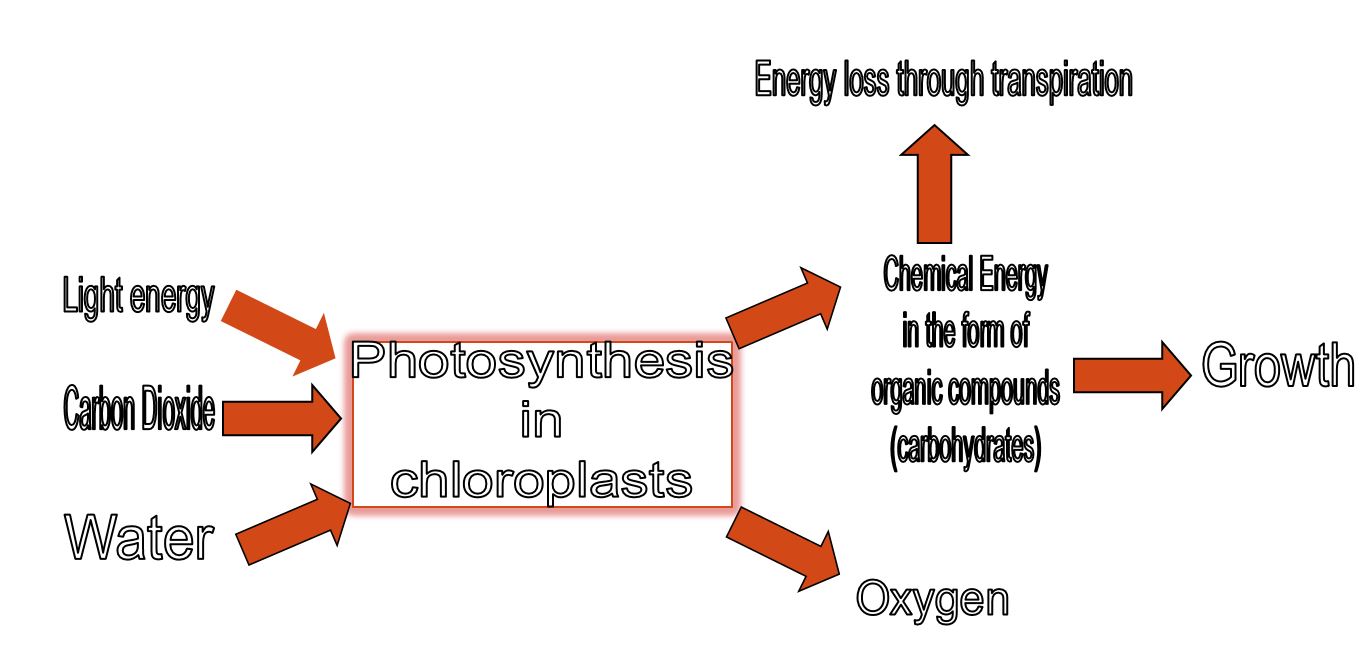2.3 Productivity
 Productivity
Productivity
In this topic we need to look at how energy enters the global system and then goes on to contribute to global productivity. This can link back to sub-topic 1.2 and 1.3 with the idea of albedo and feedback loops. We also quickly revisit photosynthesis and respiration which we explored as an introduction to energy flow within ecosystems. There seems to be a lot of definition learning for students in this concept and so I use a combination of practice questions in application of knowledge (do you understand when to use a particular formula?) and coming back to the big idea that this is how we can compare ecosystems and biomes so we need to use a standardised method and terminology.
Significant Ideas:
- Ecosystems are linked together by energy and matter flows.
- The Sun’s energy drives these flows, and humans are impacting the flows of energy and matter both locally and globally.
Recommended Teaching Time (not including practicals): 2 hours
From the Guide (IB ESS Guide 2015)
- As solar radiation (insolation) enters the Earth’s atmosphere, some energy becomes unavailable for ecosystems as this energy is absorbed by inorganic matter or reflected back into the atmosphere.
- Pathways of radiation through the atmosphere involve a loss of radiation through reflection and absorption as shown in the image on this page.
- Pathways of energy through an ecosystem include:
- conversion of light energy to chemical energy
- transfer of chemical energy from one trophic level to another with varying efficiencies
- overall conversion of ultraviolet and visible light to heat energy by an ecosystem
- re-radiation of heat energy to the atmosphere.
- The conversion of energy into biomass for a given period of time is measured as productivity.
- Net primary productivity (NPP) is calculated by subtracting respiratory losses (R) from gross primary productivity (GPP). NPP = GPP – R
- Gross secondary productivity (GSP) is the total energy or biomass assimilated by consumers and is calculated by subtracting the mass of fecal loss from the mass of food consumed. GSP = food eaten – fecal loss
- Net secondary productivity (NSP) is calculated by subtracting respiratory losses (R) from GSP. NSP = GSP – R
- Maximum sustainable yields are equivalent to the net primary or net secondary productivity of a system.
Application and Skills
- Analyse quantitative models of flows of energy and matter.
- Construct a quantitative model of the flows of energy or matter for given data.
- Analyse the efficiency of energy transfers through a system.
- Calculate the values of both GPP and NPP from given data.
- Calculate the values of both GSP and NSP from given data.
Guidance
- Students should have the opportunity to measure productivity and biomass experimentally.
- Students could design experiments to compare productivity in different systems.
- The distinction between storages of energy illustrated by boxes in energy-flow diagrams (representing the various trophic levels), and the flows of energy or productivity often shown as arrows (sometimes of varying widths) needs to be emphasized. The former are measured as the amount of energy or biomass per unit area and the latter are given as rates, for example, J m–2 yr–1.
- Students should understand the link between sustainable yields and productivity.
- Values for GPP and NPP should be compared from various biomes.
- The term “assimilation” is sometimes used instead of “secondary productivity”.
Student Tasks and Teaching Strategies
2.3 Productivity - a review activity
Practical Activity - Modelling the Albedo Effect
Try the activity on different coloured ice and speed of melting Modelling the Albedo Effect 1
Practical Activity - Demonstrating Primary Productivity
This can be introduced in a variety of places but it is useful for students to understand the link between photosynthesis and primary productivity Introducing Primary Productivity
Practical Activity - Energy Content in Biomass
You could also introduce the idea that all biomass contains energy and this can be measured. It's one of my students' favourite labs as they get to burn things! Energy Content in Biomass
The Fate of Solar Radiation
Not all solar energy ever reaches photosynthetic organisms. As solar energy reaches the earth's atmosphere 31% of the energy is reflected back out of the earth's system from clouds, the ground and molecules present in the atmosphere. A further 17% is absorbed by molecules and dust and 3 % by clouds. Just under half of the solar radiation entering the earth's atmosphere is absorbed by the ground.
These interactions are involved in the process of the greenhouse effect. See 7.2 Climate Change - Causes and the production of short wave and long wave radiation from the incoming short wave solar radiation. For a practical activity see Modelling the Albedo Effect.
This incoming energy entering as short wave radiation can be converted to chemical energy via the process of photosynthesis. The conversion of energy into the biological matter (biomass) of any trophic level over a given period of time can be measured as productivity. Energy is constantly converted to heat and re-radiated to the atmosphere.
This chemical energy is transferred, by feeding, through the trophic levels but the efficiency of this transfer varies from organism to organism and ecosystem to ecosystem. For example, the efficiency of transfer in marine ecosystems is greater than in terrestrial systems but the inital efficiency of photosynthesis is lower due to the loss of light energy as it enters water.
 Photosynthesis Leads to Primary Productivity
Photosynthesis Leads to Primary Productivity
The conversion of light energy into a primary producer's biomass in a given amount of time is measured as Primary Productivity. The initial conversion is known as the Gross Primary Productivity (GPP). After respiration losses have been accounted for, this is Net Primary Productivity (NPP).
NPP = GPP - R
There are two methods for measuring Primary productivity. These can be explored via Introducing Primary Productivity.
Past exam questions have asked students to describe how this can be measured experimentally or calculated from given data. You might also be interested in reading 5. Estimating Biomass and Energy Flow from sub-topic 2.5.
 Secondary Productivity
Secondary Productivity
All consumers can have their productivity measured by subtracting the fecal losses from the amount of food consumed. This is equivalent to the total energy or biomass assimilated into the organism's biomass.
Gross Secondary Productivity = food eaten - fecal losses
This must be within a given period of time.
Net Secondary Productivity is the simply gross secondary productivity minus respiratory losses. NSP = GSP - R
![]() Maximum Sustainable Yield
Maximum Sustainable Yield
The amount of biomass which can be removed from a system is equivalent to the net primary or net secondary productivity of a system.
More about this in aquatic systems can be viewed in 4.3 Aquatic Food Production Systems

